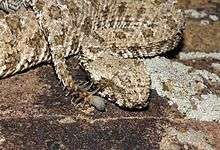Spider-tailed horned viper
| Spider-tailed horned viper | |
|---|---|
 | |
| Close-up of P. urarachnoides showing spider-like tail tip | |
| Scientific classification | |
| Kingdom: | Animalia |
| Phylum: | Chordata |
| Subphylum: | Vertebrata |
| Class: | Reptilia |
| Order: | Squamata |
| Suborder: | Serpentes |
| Family: | Viperidae |
| Subfamily: | Viperinae |
| Genus: | Pseudocerastes |
| Species: | P. urarachnoides |
| Binomial name | |
| Pseudocerastes urarachnoides Bostanchi, Anderson, Kami & Papenfuss, 2006 | |
 | |
The spider-tailed horned viper (Pseudocerastes urarachnoides) is a species of viper endemic to western Iran which was described in 2006. The head looks very similar to that of other Pseudocerastes species in the region but it has a unique tail that has a bulb-like end and bordered by long drooping scales that give it the appearance of a spider. The tail tip is waved around and used to lure insectivorous birds within striking range.[2]
Description
Like other vipers in the genus Pseudocerastes the scales above the eyes rise up to give a horned appearance. A specimen had been collected in 1968 as part of the Second Street Expedition to Iran and deposited in the Field Museum of Natural History at Chicago, identified as Pseudocerastes persicus. It was however found to be distinct and described as a new species in 2006. The species is distinguished by a number of characters. There are about 16 to 17 scales between the horns and the scales on the body above are rougher than on other species in the genus. There are 15 pairs of subcaudal scales and the scales on the sides of the tail are elongated and appear like appendages of an arthropod. The tip of the tail is inflated into a bulb-like shape.[3]
The tail resembles a spider or other arachnid and the authors who described the species speculated that it was used as a lure to attract birds as a digested lark had been found in the stomach of the paratype specimen. The tip of the tail is used as a lure in several species of snake including Bitis caudalis, Crotalus cerastes, Sistrurus catenatus, Agkistrodon contortrix, Acanthophis antarcticus, Acanthophis praelongus, and Morelia viridis but none of these examples have the unique elongated scales that give it the appearance of arthropod appendages.[2][4] The actual use of the tail to lure birds was confirmed by later studies in the field.[5]
A video of a viper using its tail to resemble a moving spider to lure and catch a bird was made during the study.[6]
This species overlaps in distribution with P. fieldi in Gilan-e-Gharb, next to Qasr-e-Shirin, Kermanshah and with P. persicus in Bina and Bijar, Ilam province.[3] Molecular studies based on cytochrome b show it to be evolutionarily closer to Pseudocerastes persicus than to P. fieldi.[7]
Etymology
The specific name, urarachnoides, is derived from Ancient Greek (οὐρά tail + ἀράχνη spider + οειδής like), and refers to this snake's spider-like tail tip, as does the common name, spider-tailed horned viper.[2]
References
- ↑ Anderson, Steven C.; Theodore Papenfuss (2009). "Pseudocerastes urarachnoides". IUCN Red List of Threatened Species. Version 2012.2. International Union for Conservation of Nature. Retrieved 3 June 2013.
- 1 2 3 Bostanchi, H.; Anderson, S. C.; Kami, Haji Gholi; Papenfuss, T.J. (2006). "A new species of Pseudocerastes with elaborate tail ornamentation from western Iran (Squamata: Viperidae)" (PDF). Proc. California Acad. Sci. 4. 57 (14): 443–450.
- 1 2 Fathiia, Behzad; Rastegar-Pouyani, Nasrullah (2010). "On the species of Pseudocerastes (Ophidia: Viperidae) in Iran". Russian Journal of Herpetology. 17 (4): 275–279.
- ↑ Fathinia, Behzad; Anderson, Steven C.; Rastegar-Pouyani, Nasrullah; Jahani, Hasan; Mohamadi, Hosien (2009). "Notes on the natural history of Pseudocerastes urarachnoides (Squamata: Viperidae)". Russian Journal of Herpetology. 16 (2): 134–138.
- ↑ Fathinia, Behzad; Rastegar-Pouyani, Nasrullah; Rastegar-Pouyani, Eskandar; Todehdehghan, Fatemeh; Amiri, Fathollah (2015). "Avian deception using an elaborate caudal lure in Pseudocerastes urarachnoides (Serpentes: Viperidae)". Amphibia-Reptilia. 36 (3): 223–231. doi:10.1163/15685381-00002997.
- ↑ 11, James Owen PUBLISHED April; 2016. "This Snake Pretends to Be a Spider—and Catches a Bird". National Geographic News. Retrieved 2016-04-11.
- ↑ Fathinia, Behzad; Rastegar-Pouyani, Nasrullah; Rastegar-Pouyani, Eskandar; Toodeh-Dehghan, Fatemeh; Rajabizadeh, Mehdi (2014). "Molecular systematics of the genus Pseudocerastes (Ophidia: Viperidae) based on the mitochondrial cytochrome b gene" (PDF). Turkish Journal of Zoology. 38: 575–581. doi:10.3906/zoo-1308-25.
External links
| Wikimedia Commons has media related to Pseudocerastes urarachnoides. |
